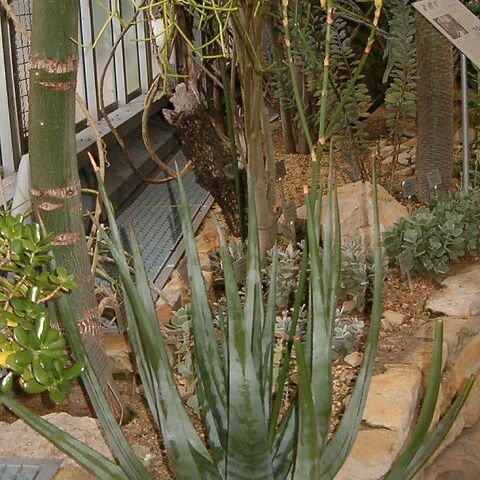Plants usually stemless, 500-800 mm tall excluding inflorescence, not suckering. Leaves 40-50, erect to arcuate-erect, 400-900 x 40-150 mm, deep green to glaucous green. Inflorescence 5-8-branched, 1.25-1.75 m tall; racemes subdense; sterile bracts few; bracts broadly ovate-acuminate, 13-20 x 8-12 mm, many-nerved. Flowers red, yellow, or red in bud and yellow at flowering, 25-45 mm long; all segments free; pedicels 8-20 mm long. Anthers exserted 1-4 mm. Ovary 6.0-9.0 x 2.5-4.0 mm, green; style exserted 3-5 mm. Fruit 20-23 x 11-13 mm, buff-grey. Seeds grey, ±5 x 4 x 1 mm, wing moderately narrow, translucent. Flowering time June to August in most populations, but February to March in some.
Leaves in a compact rosette, stiffly erect and curving slightly inwards; lamina to 60(90) cm long, 7–10(13) cm wide toward the base, lanceolate-attenuate, dull dark greyish-green, tinged purplish in dry conditions, without spots, slightly rough on the surface; margin with pungent deltoid brown-tipped teeth 1–3 mm long and 5–8 mm apart; sap bright yellow, drying purplish.
Acaulescent, succulent herb, up to 0.8 m high, excluding inflorescence. Leaves over 600 x 90 mm. Bracts many-nerved, ± 20 mm long. Inflorescence 5-8-branched, 1.25-1.75 m tall. Racemes subdense. Flowers red, yellow or red in bud and yellow at anthesis.
Perianth bright orange-scarlet, paler-to yellowish-tipped when fully open, green-tipped in bud, 28–35 mm long, c. 9 mm in diameter across the ovary, cylindric-trigonous; outer segments free to the base, tips scarcely spreading.
Racemes 20–45 × 6–7 cm, narrowly cylindric-acuminate, densely flowered, the buds covered by the bracts; bracts 10–15 × 8–12 mm, broadly ovate-cuspidate, scarious, brownish, many-nerved; pedicels c. 20 mm long.
Inflorescences 1–3, erect, 1–1.75 m high; peduncle 1–4-branched; branches erect, subtended by scarious deltoid bracts up to 18 × 18 mm, and with several sterile bracts below each raceme.
A herb that keeps growing from year to year. The leaves are in a compact ring. It grows 50-80 cm tall. There are 40-50 leaves 40-90 cm long by 4-15 cm wide.
Perennial herb, solitary or suckering to form small groups of plants, acaulescent or with a very short decumbent stem.
Seeds 4 × 5 mm, blackish-brown with narrow very dark yellowish-brown wings.
Capsule 20–30 × 13 mm, ovoid, yellowish-brown.
Stamens and stigma exserted c. 3 mm.

